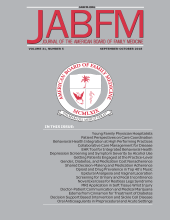Article Figures & Data
Tables
- Table 1. Demographics of Chronic Kidney Disease (CKD) Stage 3 Patients at Three Residency Teaching Sites
Characteristic Total Sample (n = 325) Buffalo Practice 1 (n = 109) Buffalo Practice 2 (n = 95) Kansas City Practice (n = 121) Female sex 56 (182) 61 (67) 44 (42) 60 (73) Age (years) Mean (SD) 66.8 (13.5) 67.8 (13.4) 63 (12.8) 69.1 (13.5) Range 32–96 32–96 35–93 34–95* Race/ethnicity Hispanic (any race) 3 (11) 5 (5) 0 (0) 5 (6) Black 68 (222) 83 (90) 86 (82) 41 (50) White 25 (82) 10 (11) 14 (13) 56 (58) American Indian/Alaska Native 0 (1) 0 (0) 0 (0) 0.8 (1) Asian/unknown/other/decline to answer 5 (15) 3 (3) 0 (0) 10 (12) Data are % (n) unless otherwise indicated.
↵* Data from one patient are missing.
SD, standard deviation.
ICD-9 Code 585.3 Race/ethnicity White, African American, Hispanic, or Native American Age Numeric value Body mass index Numeric value Two most recent GFR values, with dates Numeric value* Two most recent ACR values, with dates Numeric value* Diagnosis based on GFR correct? Yes/No Diagnosis based on ACR correct? Yes/No ACR date Date ACR verified? (2 successive ACRs at least 90 days apart) Dates and values of the 2 ACRs Comorbidities Diabetes mellitus Yes/no Hypertension Yes/no Congestive heart failure Yes/no Sleep apnea Yes/no Acute kidney injury Yes/no Coronary artery disease Yes/no ↵* Values were recorded only at the Buffalo sites.
ACR, albumin-to-creatinine ratio; GFR, glomerular filtration rate; ICD-9, International Classification of Diseases, Ninth Revision.
Site Patients, n Prevalence of Misdiagnosis, n (%) Buffalo practice 1 109 48 (44) Buffalo practice 2 95 52 (54) Kansas City practice 121 54 (45) Total 325 154 (47) Patients (n) Prevalence (%) Buffalo Practice 1 (48) Buffalo Practice 2 (52) Total (100) 1 Normal, 1 abnormal GFR 19 18 37 37 1 Normal GFR 3 8 11 11 1 Abnormal GFR 6 6 12 12 2 Normal GFRs 19 14 33 33 No recorded GFRs 1 6 7 7 No recorded ACRs 42 18 60 60 ↵* Data are from the Buffalo sites only.
ACR, albumin-to-creatinine ratio; GFR, glomerular filtration rate.






